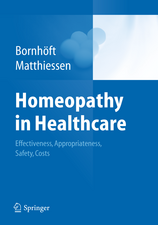Ultra High Dilution: Physiology and Physics
Editat de P.C. Endler, J. Schulteen Limba Engleză Hardback – 31 ian 1994
| Toate formatele și edițiile | Preț | Express |
|---|---|---|
| Paperback (1) | 1093.52 lei 6-8 săpt. | |
| SPRINGER NETHERLANDS – dec 2010 | 1093.52 lei 6-8 săpt. | |
| Hardback (1) | 1100.64 lei 6-8 săpt. | |
| SPRINGER NETHERLANDS – 31 ian 1994 | 1100.64 lei 6-8 săpt. |
Preț: 1100.64 lei
Preț vechi: 1158.57 lei
-5% Nou
Puncte Express: 1651
Preț estimativ în valută:
210.60€ • 220.48$ • 174.26£
210.60€ • 220.48$ • 174.26£
Carte tipărită la comandă
Livrare economică 05-19 aprilie
Preluare comenzi: 021 569.72.76
Specificații
ISBN-13: 9780792326762
ISBN-10: 0792326768
Pagini: 268
Ilustrații: XII, 268 p.
Dimensiuni: 156 x 234 x 18 mm
Greutate: 0.58 kg
Ediția:1994
Editura: SPRINGER NETHERLANDS
Colecția Springer
Locul publicării:Dordrecht, Netherlands
ISBN-10: 0792326768
Pagini: 268
Ilustrații: XII, 268 p.
Dimensiuni: 156 x 234 x 18 mm
Greutate: 0.58 kg
Ediția:1994
Editura: SPRINGER NETHERLANDS
Colecția Springer
Locul publicării:Dordrecht, Netherlands
Public țintă
ResearchCuprins
1: Physiology.- Hormesis: Dose Dependent Reverse Effects of Low and Very Low Doses.- Reappraisal of a Classical Botanical Experiment in UHD Research. Energetic Coupling in a Wheat Model.- Immunological Examples on UHD Research.- Further Biological Effects induced by UHDs. Inhibition by a Magnetic Field.- A Zoological Example on UHD Research. Energetic Coupling between the Dilution and the Organism in a Model of Amphibia.- Scientific Proving of an UHD on Humans.- Physiological Effects of Homoeopathic Medicines in Closed Phials; A Critical Evaluation.- 2: Physics.- Outline of Experimental Physical Methods to Investigate Specific Structures of UHDs.- Conservation of Structure in Aqueous UHDs.- Is the “Memory of Water” a Physical Impossibility?.- Small Water Clusters (Clathrates) in the Homoeopathic Preparation Process.- Mass, Fluid and Wave Motion During the Preparation of UHDs.- UHD Effect and Isotopic Self-Organisation.- About Quality and Standards in UHD Research and Research on Homoeopathy.- 3: Biophysics.- Some Biophysical Elements of Homoeopathy.- Electromagnetic and Magnetic Vector Potential Bio-Information and Water.- Resonance Phenomena of an UHD.- Transfer of Information from Molecules by Means of Electronic Amplification.- Effects of Typical Thyroxine Related Frequencies on Amphibia.- 4: The Historical and Medical Context.- Characteristics and Selected Results of Research on Homoeopathy.- Homoeopathy with Special Regard to Immuno-allergological Research.- Clinical Studies of Homoeopathy. The Problem of a Useful Design.- Prospects.- Preliminary Elements of a Theory on UHD.- Epilogue.- Alternative Research or Research on Alternatives?.- Summary.
Recenzii
` . . . a most welcome tome and makes a significant contribution to the understanding of the way homeopathic medicines work. This book adds significantly to our understanding and will therefore appeal not only to the homeopathic buff but also to the scientific community as a whole. I can strongly recommend this book which is certain to become a classic in the fields of ultra high dilution research and homeopathy in general. '
HomInt R&D Newsletter, 1/94
HomInt R&D Newsletter, 1/94














